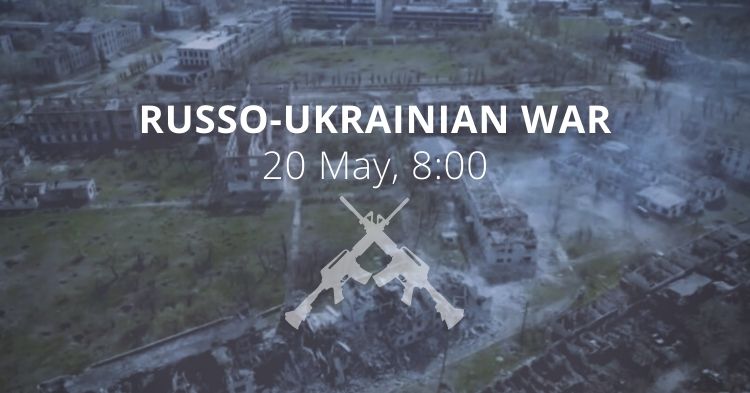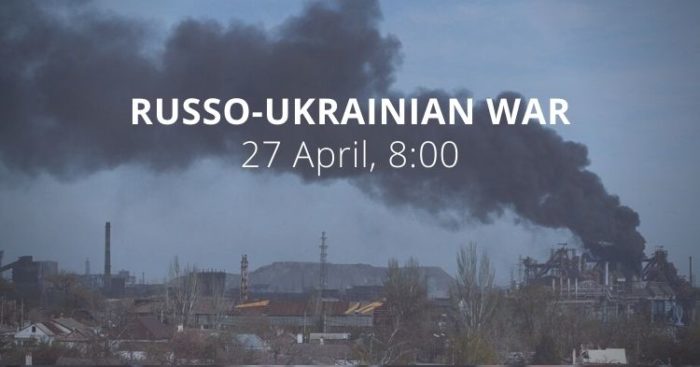Russia used incendiary projectiles and what appears to be phosphorous weapons in Bakhmut. If Wagner retreats, Kadyrovtsy to take over the fight in Bakhmut--unconfirmed. Kremlin ideologist Prilepin wounded in an assassination attempt in Russia.
https://twitter.com/EuromaidanPress/status/1654958967733514240
Daily overview — Summary report, May 7
A map of the approximate situation on the ground in Ukraine as of 00:00 UTC 07/05/23.
There have been no notable changes to control since the last update. pic.twitter.com/J1pwwzm3VM
— War Mapper (@War_Mapper) May 7, 2023
The General Staff’s operational update regarding the Russian invasion as of 18.00 pm, May 7, 2023 is in the dropdown menu below:
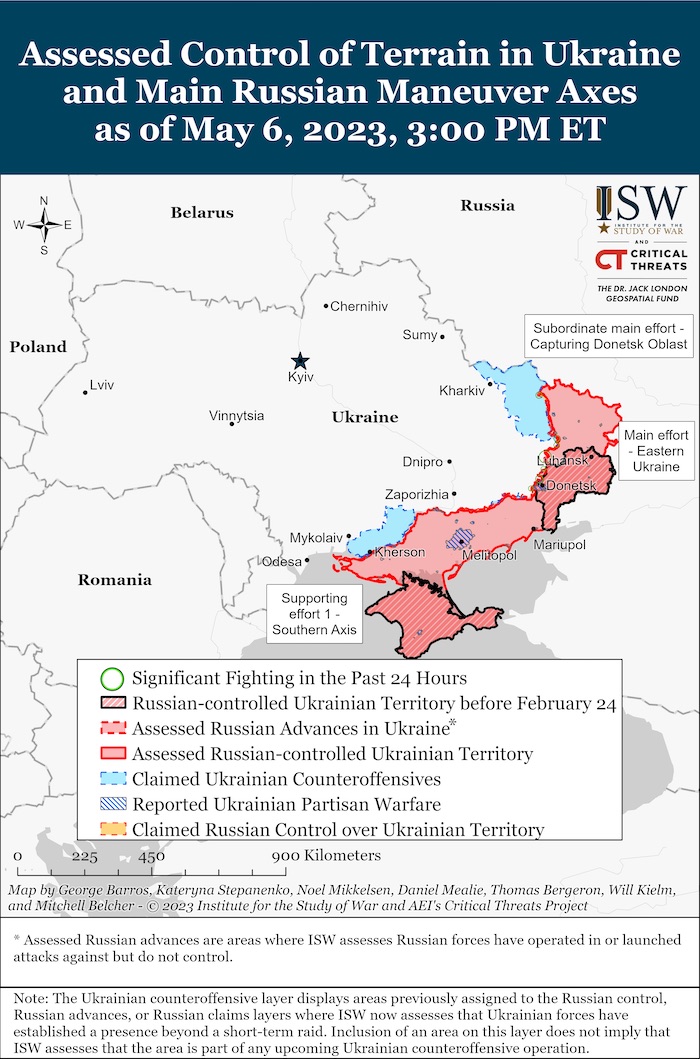
On May 6, the adversary launched 6 missile attacks, in particular on the cities of Chasiv Yar, Kostiantynivka, and Kherson. In addition, the invaders launched 48 air strikes and 77 MLRS attacks at the positions of Ukrainian troops and various settlements. The attacks caused casualties and destroyed and damaged private housing and other civilian infrastructure.
The likelihood of missile and air strikes across Ukraine remains quite high.
The adversary continues to focus its main efforts on Lyman, Bakhmut, Avdiivka, and Marinka axes. Heavy fighting for the cities of Bakhmut and Marinka continues. In total, Russian forces launched about 50 attacks on May 6.
- Volyn and Polissya axes: no signs of the formation of offensive enemy groups were found. Training of Russian forces’ territorial defence units continues at the training grounds of the Republic of Belarus.
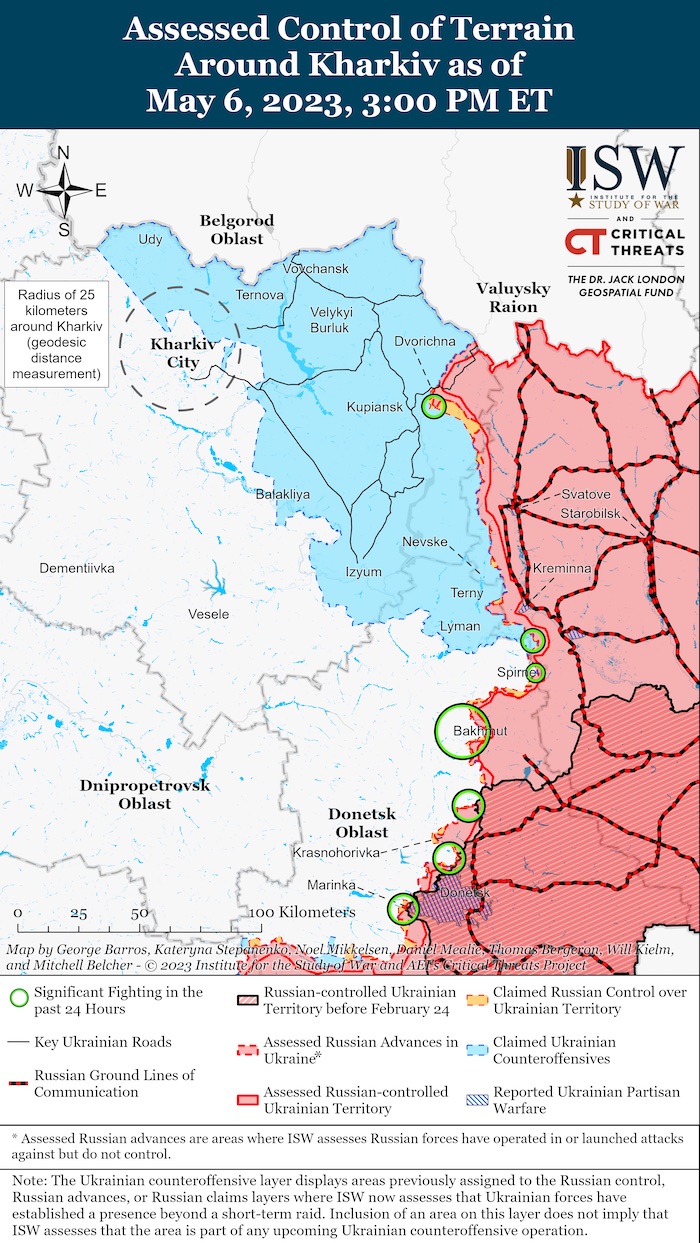
- Sivershchyna and Slobozhanshchyna axes: Russian forces conducted air strikes on the vicinities of Zarichchya, Leonivka, and Krasnyi Khutir (Chernihiv oblast) on May 6. The invaders fired mortars and artillery at the settlements of Khrinivka, Karpovychi, Tymonovychi, Zaliznyi Mist, Leonivka (Chernihiv oblast), Ukrainske, Rivne, Sopych, Boyaro-Lezhachi, Volfyne (Sumy oblast), Lemishchyne, Hraniv, Kozacha Lopan’, Strilecha, Luk’yantsi, Neskuchne, Starytsya, Vovchans’ki Khutory, Okhrymivka, Chorne, and Khatnje (Kharkiv oblast).
- Kupiansk axis: the adversary conducted unsuccessful offensives towards Syn’kivka. The invaders shelled Krasne Pershe, Mytrofanivka, Novomlyns’k, Dvorichna, Zapadne, Syn’kivka, Pishchane, Vyshneve, and Stel’makhivka (Kharkiv oblast).
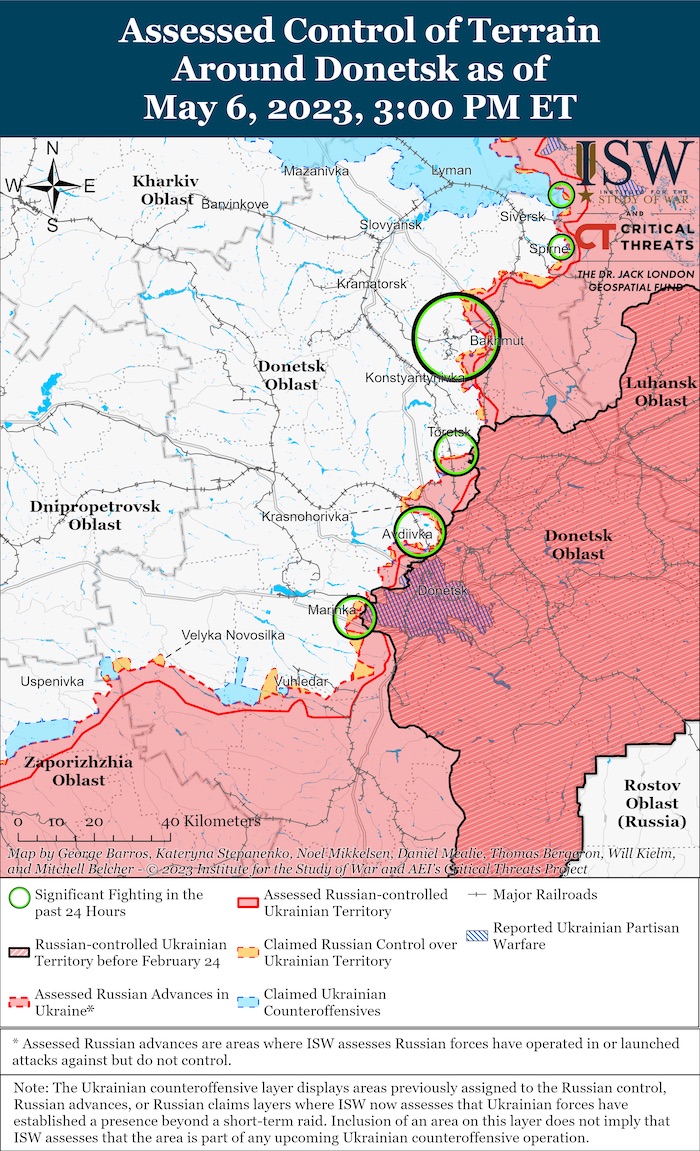
- Lyman axis: the adversary conducted offensive operations towards Bilohorivka and Spirne, to no success. Makiivka, Nevske (Luhansk Oblast), Bilohorivka, and Spirne (Donetsk Oblast) were shelled with artillery.
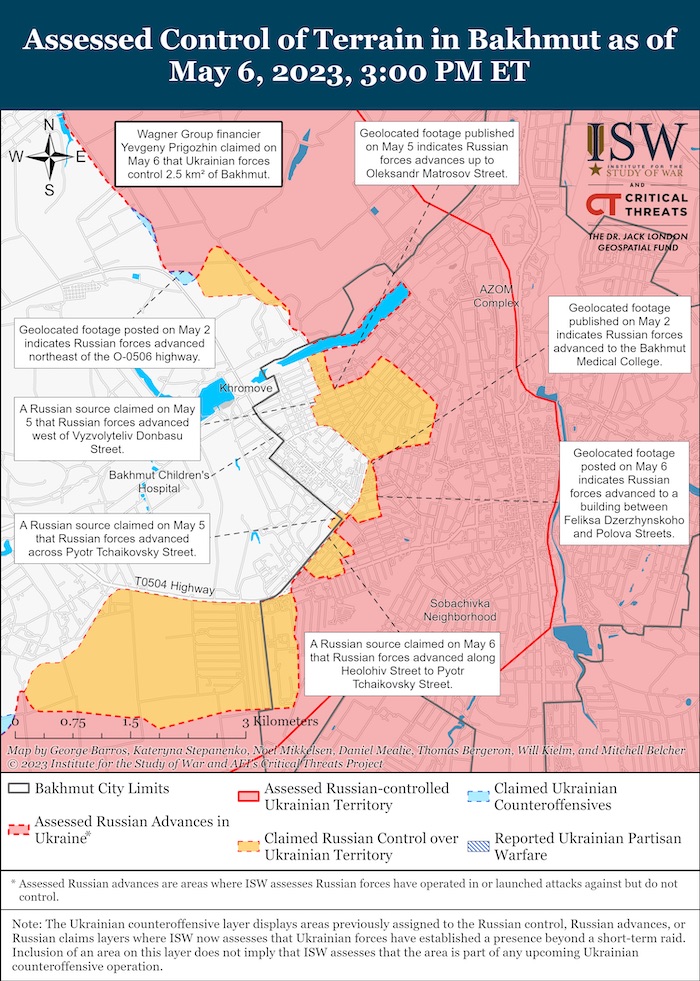
- Bakhmut axis: Russian forces continue their offensive operations. Battles in the city of Bakhmut continue. Also, the adversary conducted unsuccessful offensives towards Bohdanivka, Ivanivske, Predtechyne, and New York on May 6. Vesele, Min’kivka, Orikhovo-Vasylivka, Markove, Bakhmut, Ivanivske, Chasiv Yar, Kostiantynivka, Oleksandro-Shul’tyne, Pivdenne, Toretsk, Pivdenne, and New York (Donetsk oblast) suffered from enemy shelling.
- Avdiivka axis: the adversary did not conduct any offensive operations on May 6. The invaders shelled Berdychi, Avdiivka, Sjeverne, Karlivka, Netaylove, and Pervomais’ke (Donetsk oblast).
- Marinka axis: Ukrainian defenders repelled numerous enemy attacks in the vicinity of the city of Marinka. At the same time, the settlements of Heorhiivka and Pobjeda (Donetsk oblast) were shelled by Russian forces.
- Shakhtarske axis: no enemy offensive operations The occupant forces shelled Vodyane, Vuhledar, Prechystivka, and Zolota Nyva (Donetsk oblast).
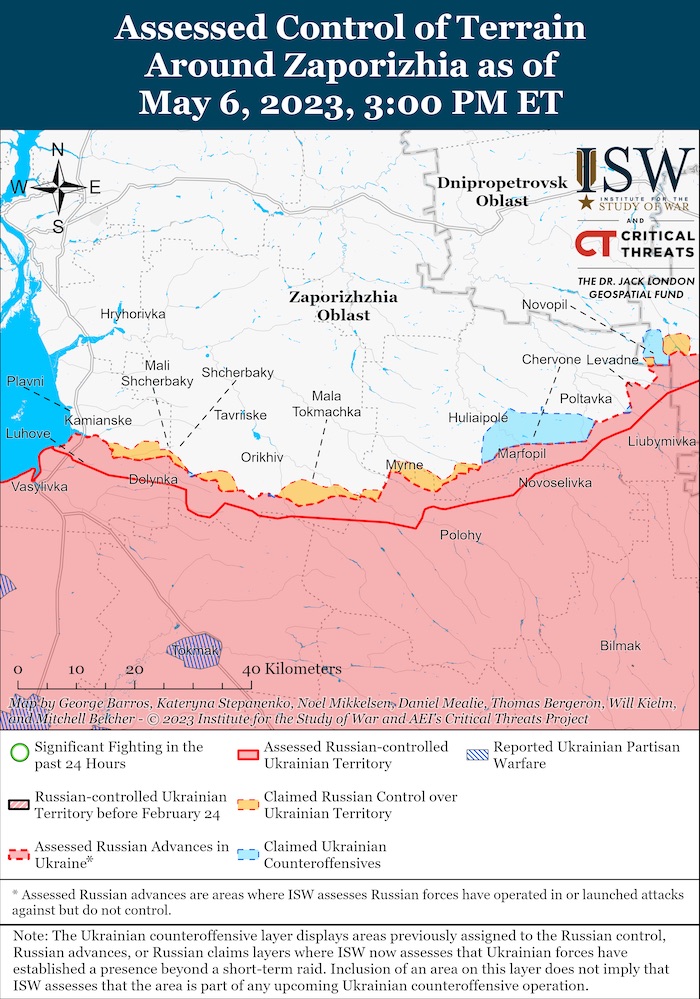
- Zaporizhzhia and Kherson axes: the adversary continues to defend. Also, the invaders shelled numerous settlements, including Burlats’ke, Vil’ne Pole, Novosilka, Novopil’ (Donetsk oblast), Ol’hivs’ke, Malynivka, Hulyaipole, Zaliznychne, Huliaipilske, Charivne, Bilohir’ya, Mala Tokmachka, Novodanylivka, Mali Shcherbaky, Kam’yans’ke (Zaporizhzhia oblast), Nikopol’ (Dnipropetrovsk oblast), Zolota Balka, Antonivka (Kherson oblast), and the city of Kherson. The invaders launched air strikes on the settlements of Vesele and Kozats’ke (Kherson oblast).
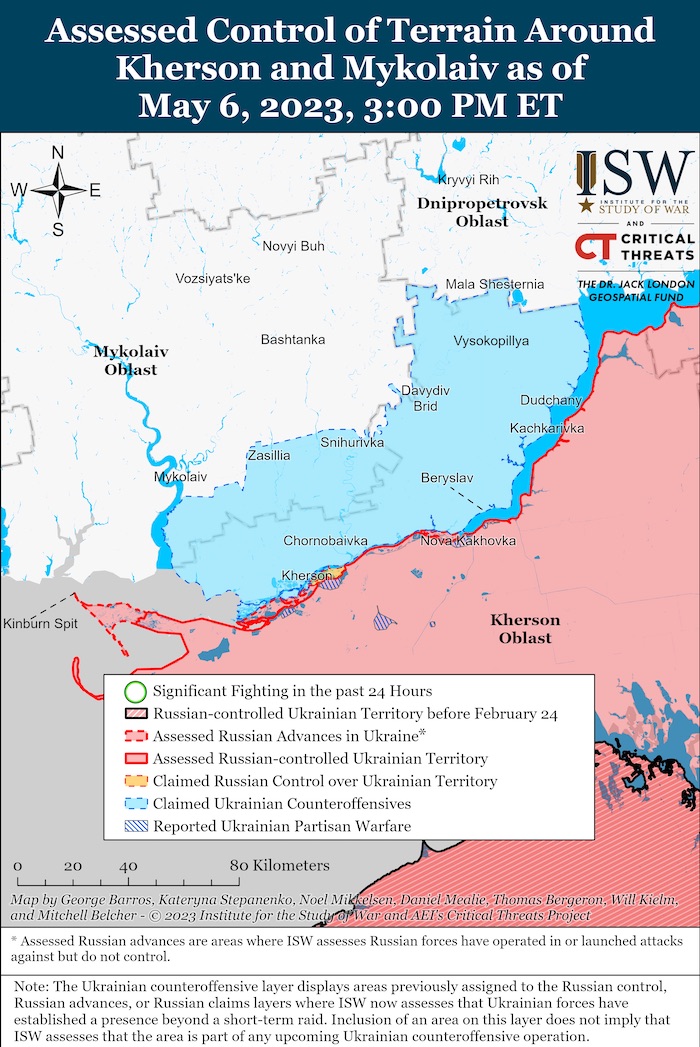
Russian occupants are evacuating civilians from the temporarily occupied Enerhodar (Zaporizhzhia oblast) to local recreation centres in the settlements of Berdiansk and Prymors’k. People with Russian passports are subject to evacuation. The first to be evacuated are those who accepted Russian citizenship in the first months of the occupation.
The Russian occupiers keep using the infrastructure of the temporarily occupied settlements to provide medical care to their wounded soldiers. Recently, the invaders set up a field hospital in one of the villages of Starobil’s’kyi district (Luhansk oblast) where up to 70 people are undergoing treatment.
[The Russian occupiers do not stop robbing Ukrainian citizens and businesses in the temporarily occupied territories. In Energodar, as of May 5, not a single car was left on the territory of the Elektropivdenmontazh-10 enterprise. The warehouse was looted, and machine tools were also taken away.]
[Increasingly, information is being received about the low level of morale and psychological condition of Russian forces personnel. Thus, in one of the divisions of the Russian occupation forces, located in the village of Mulino, Nizhny Novgorod region, commanders openly refer to subordinates as "cannon fodder." In addition, servicemen complain about unsatisfactory medical care, as well as the provision of personal protective equipment and equipment. About 50% of the personnel do not have the opportunity to issue payment cards, they fear that in the event of their death, their funds will not reach their families.]
On May 6, the Ukrainian Air Force launched 7 air strikes on the concentrations of troops and military equipment of the adversary, as well as 1 air strike on the anti-aircraft missile system of Russian forces.
On May 6, the Ukrainian defenders intercepted 7 combat and 8 reconnaissance UAVs.
In the meantime, the Ukrainian missile and artillery troops hit 1 command post, 3 concentrations of weapons and military equipment of the adversary, as well as 1 artillery unit at its firing position.
Military Updates
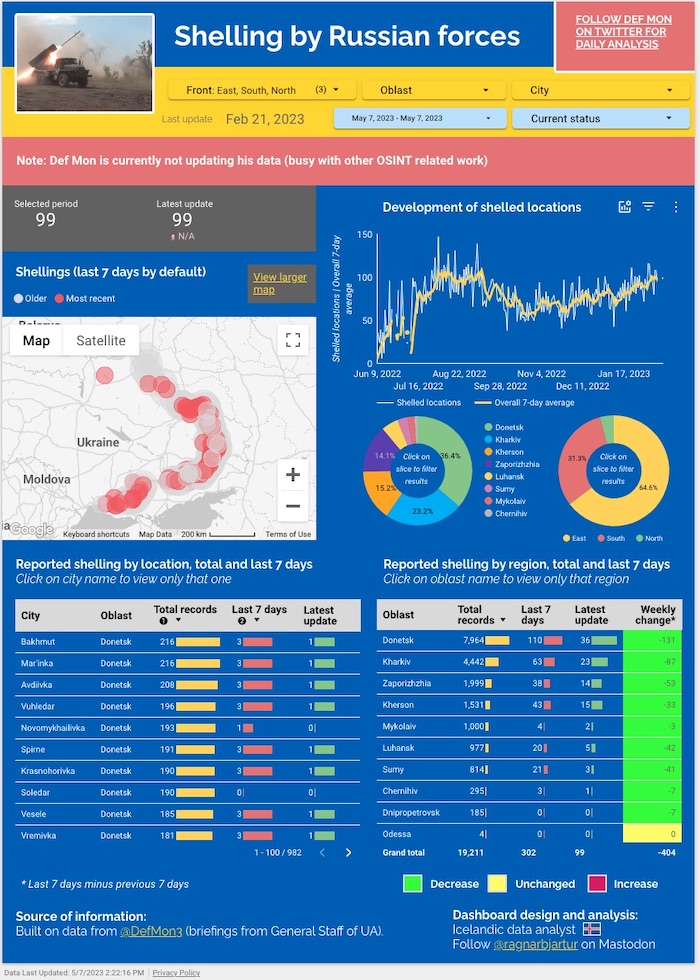
Ukraine's Air Force announces downing of Kinzhal missile using Patriot air-defence system, Ukrainska Pravda reports. “Lieutenant General Mykola Oleshchuk, Commander of the Air Force of the Armed Forces of Ukraine, has said that the Ukrainian military shot down the Russian Kinzhal missile. It happened during the night attack on 3-4 May in the skies over Kyiv Oblast. The Kh-47 missile was launched by the MiG-31K from the territory of Russia.
The Defense Express media outlet, after analysing photos of the missile wreckage, suggested that a hypersonic Kh-47 Kinzhal missile had been successfully shot down over Kyiv for the first time in the early hours of 4 May.”
Blasts rock northern part of Russia-occupied Crimea, Ukrinform reports, citing Suspilne. “On the morning of May 6, explosions rang out in the town of Dzhankoi in the northern part of the Russian-occupied Crimean Peninsula. This morning, May 6, there were explosions in occupied Dzhankoi. The invaders claimed it was due to the air defence system operating at the time, the statement reads.
According to Oleh Kryuchkov, adviser to the head of the occupation administration, no casualties or damage were reported.”
Ukraine launches more than 10 drones on Crimea - Russia-installed official, Reuters reports. “Ukraine launched more than 10 drones overnight on the Crimean Peninsula, including three on the port of Sevastopol, a Russian-installed official said early on Sunday, adding that air defence systems repelled all the attacks on Sevastopol. […] Baza, a Telegram channel with links to Russia's law enforcement agencies, reported earlier on Sunday that according to the channel's preliminary information, there were no casualties in what it said was a series of attacks on Crimea.
According to Ukrainian monitoring of Telegram channels, explosions took place in Sevastopol and Saki - where Russia has an air base - as well as a few other places. Strikes on Russian-held targets have intensified in the past two weeks, especially in Crimea. Ukraine, without confirming any role in those attacks, says destroying infrastructure in preparation for its planned ground assault.”
Air Force units destroy five more Russian drones, Ukrinform reports. "On May 6, the air defence forces and means of the Air Force of the Armed Forces of Ukraine destroyed five enemy UAVs: four operational-tactical level drones and one Lancet combat drone," Lieutenant General Mykola Oleshchuk, Commander of the Air Force of the Armed Forces of Ukraine, posted on Telegram.
As reported, on the night of May 6, Russian troops attacked Ukraine with Shahed-136/131 kamikaze drones from the south. The Air Force destroyed all eight enemy UAVs.”
Wagner mercenaries in Bakhmut to be replaced by Kadyrovites
Russia's Wagner Group will pull out its forces from Bakhmut on 10 May and hand over positions to the Chechen leader Ramzan Kadyrov's troops.https://t.co/55dq2V8BdO
— Euromaidan Press (@EuromaidanPress) May 6, 2023
Bakhmut on fire: Russia uses phosphorus bombs en masse – SOF, Ukrainska Pravda reported Friday. "The enemy used phosphorous and incendiary ammunition in Bakhmut, trying to wipe the city off the face of the Earth. However, the soldiers of the SSO and other units of the Defence Forces continue to courageously defend the city. And in these conditions, we continue to destroy the enemy.
On 5 May, Yevgeny Prigozhin, founder of the Wagner Private Military Company (PMC), wrote a letter to the Russian Defence Ministry, stating that he will withdraw the Wagner PMC mercenaries from Bakhmut after 10 May.
The Armed Forces of Ukraine are sceptical about the claim made by Yevgeny Prigozhin, the leader of the Wagner Group. According to Ukrainian military personnel and intelligence, Russians will try to put pressure on the defenders of Bakhmut until 9 May.”
Chechen leader says his fighters ready to replace Wagner Group "cannon fodder" in Bakhmut, Ukrainska Pravda reports. “Chechen leader Ramzan Kadyrov has said that he was prepared to send Kadyrovites [Chechen forces subordinate to Kadyrov and fighting as part of the Russian army – ed.] to Bakhmut, to replace Wagner Group mercenaries who allegedly want to leave the city. Bakhmut remains the hottest spot on the front, and hundreds of Russian soldiers and Wagner Group mercenaries are being killed there. Wagner Group leader Yevgeny Prigozhin has previously accused Russian military leadership of failing to supply ammunition to his fighters, resulting in high rates of fatalities.
Kadyrov addressed Wagner Group leader Yevgeny Prigozhin, Russian Defence Minister Sergey Shoigu, and Chief of Staff of the Russian Armed Forces Valery Gerasimov and urged the three of them to make peace. He said public squabbles made both Russian forces and civil society less motivated.
Kadyrov further said that he was disappointed to hear Prigozhin’s claims and twice as disappointed that the Russian Defence Ministry leadership has not responded to or met with Wagner Group leaders. He said that when Kadyrovites requested five tanks from the Russian Defence Ministry during the siege of Mariupol, they were only given one. […]
Kadyrov criticised both the state of Russian military equipment and Prigozhin’s decision to show images of Wagner Group mercenaries who had been killed in battle. It is wrong to film the bodies of one’s killed brothers-in-arms to make a public splash. Let’s never do that.
In an attempt to shame Prigozhin, Kadyrov said that Kadyrovites also face daily problems in the areas they are responsible for, and yet his commanders never take it to the Internet to complain but rather raise any issues via internal channels of communication with the leadership.”
Wagner Group's financier says to hand over positions in Bakhmut to Kadyrovites, Ukrainska Pravda reports, citing Prigozhin’s press service. “Yevgeny Prigozhin, the financier of the Wagner Private Military Company, has said that he would hand over his mercenaries' positions in the city of Bakhmut to Kadyrovites, the troops of Ramzan Kadyrov, Head of the Chechen Republic, subordinated to Russia’s Armed Forces. [Chechen Republic is a Federal Subject of Russia; Ukraine recognised it as a territory temporarily occupied by Russia – ed.]
I am grateful to Ramzan Akhmatovich [Kadyrov] for agreeing to take up our position in Bakhmut, most likely, having the ability to obtain everything he needed and all the necessary resources. I am already in touch with his representatives to start the transfer of positions immediately so that on 10 May, at 00:00, precisely at the moment when we estimate that our combat potential will be completely exhausted, our comrades-in-arms will take our places and continue the assault on the city of Bakhmut.”
Russia's Wagner threatens to leave Bakhmut, Ukraine says mercenaries reinforcing, Reuters reports. “Wagner Group leader Yevgeny Prigozhin said his men had been starved of ammunition and would expect the army to take their place in Bakhmut next Wednesday, jeopardising what has long been Russia's main target in its attempt to carve up its neighbour. […]
It was not clear whether Prigozhin, who often makes impulsive comments, would proceed with the withdrawal of his men got more ammunition or if the dispute might be a smokescreen. A senior Ukrainian official said Russia was bringing Wagner mercenary fighters from along the front line to Bakhmut to capture it by Victory Day.
We are now seeing them pulling (fighters) from the entire offensive line where the Wagner fighters were, they are pulling (them) to the Bakhmut direction, Deputy Defence Minister Hanna Maliar said on Ukrainian television.”
Up to 32 Kalibr missiles in the Black Sea, the danger of missile attacks high – Operational Command South, Ukrainska Pravda reports, citing Operational Command South. "The enemy has replenished the group with four missile carriers in the Black Sea. The total capacity is up to 32 Kalibr missiles. Against the background of the activity of Russian strategic aviation, the level of missile danger is at the highest possible level. Do not ignore the air-raid alarms!"
https://twitter.com/EuromaidanPress/status/1655045035078074368
According to British Defence Intelligence, (last 48 hours):
- Russia is almost certainly facing its worst labour shortage in decades. The Russian Central Bank surveyed 14,000 employers and found that the number of available employees was at its lowest level since 1998.
- Over the last three years, Russia’s population has reportedly decreased by two million more people than expected due to the impacts of COVID-19 and the war in Ukraine. Russia saw up to 1.3 million people leave the country in 2022, including many younger and well-educated people in high-value industries.] The Russian Ministry of Communications said that about 10% (100,000) of the IT workforce left the country in 2022 and did not return.
- Mobilisation, historically high emigration, and an ageing and shrinking population are limiting the labour supply.
- This will likely lead to a reduction in the potential growth of the Russian economy and risks stoking inflation.
- Six Russian regions occupied Crimea, and 21 cities have cancelled their 09 May Victory Day parades citing security concerns. Victory Day commemorates the Soviet Union’s victory over Nazi Germany. Moscow's Victory Day celebration is likely to go ahead but on a smaller scale. Russian President Vladimir Putin’s reception following the parade (last held in 2019) will not go ahead.
- The traditional March of the Immortal Regiment, where family members display photographs of deceased veterans of the Second World War, associated with Victory Day, has also been cancelled. This follows the recent cancellation of the Russian-hosted International Army Games.
- The timing of the UAV strike on the Kremlin a few days before Victory Day shows Russia’s increasing vulnerability to such attacks and has almost certainly raised the threat perception of the Russian leadership over the Victory Day events. The potential for protests and discontent over the Ukraine war is also likely to have influenced the calculus of the Russian leadership.
Losses of the Russian army
Russia's estimated losses in Ukraine as of day 438 of the all-out war, according to Ukraine's GenStaff pic.twitter.com/DfPRnvOLNs
— Euromaidan Press (@EuromaidanPress) May 7, 2023
As of Sunday 7 May, the approximate losses of weapons and military equipment of the Russian Armed Forces from the beginning of the invasion to the present day:
- Personnel – about 194430 (+660)
- Tanks – 3723 (+6)
- Armoured combat vehicles – 7248 (+10)
- Artillery systems – 3010 (+18)
- Multiple rocket launchers –MLRS - 554 (+2)
- Air defence means – 306 (+0)
- Aircraft - 308 (+0)
- Helicopters - 294 (+0)
- Automotive technology and fuel tanks – 5952 (+16)
- Vessels/boats - 18 (+0)
- UAV operational and tactical level – 2572 (+18)
- Special equipment – 380 (+5)
- Mobile SRBM system – 4 (+0)
- Cruise missiles – 947 (+0)
Russian commanders tell their soldiers they are "cannon fodder": Ukraine’s General Staff on Russian forces' morale, Ukrainska Pravda reports, citing the Ukrainian General Staff. "There is more and more information about low morale among enemy forces. Commanders of an occupation forces unit stationed in the village of Mulino, Nizhny Novgorod Oblast, are openly referring to their subordinates as ‘cannon fodder’.
[Russian] military personnel also complain about medical care, and a lack of personal protection and equipment. Around 50% of military personnel are unable to obtain their payment cards and are concerned that their families might not receive their money in case of their death."
Humanitarian
Ukraine brings 45 Azovstal defenders home from Russian captivity, Ukrainska Pravda reports. “Andrii Yermak, Head of the Office of the President of Ukraine, has reported that 45 Ukrainian defenders were brought back from Russian captivity.
42 men and three women who defended Azovstal [steel plant in Mariupol - ed.]. All of them are fighters of the National Guard’s regiment, created nine years ago on the Azov Sea coast. 35 privates and sergeants, 10 officers.
Among them are soldiers who married during the defence of Mariupol, on Azovstal. There is also our soldier, who, before the full-scale invasion, was held captive by the Russians for two and a half years, captured during the Shyrokyne operation.”
Hundreds of Ukraine’s female soldiers remain in Russian captivity - Coordination HQ, Ukrinform reports, citing Bohdan Okhrimenko and Viktoriya Tsymbaliuk, members of the Coordination Headquarters for the Treatment of Prisoners of War. "Several hundred Ukrainian military servicewomen are in enemy dungeons, Okhrimenko reported. The Coordination HQ and other relevant government bodies are working to ensure their return as soon as possible. Tsymbaliuk added that Ukraine, for its part, adheres to the norms of the Geneva Convention, which prohibits holding in custody military servicewomen, demanding a mirror attitude from Russia.
Ukraine adheres to the Geneva Convention. Russian military servicewomen who had been captured were then repatriated. We demand this from the Russian side as well: to return the captured women without any preconditions or exchanges, official said.
According to Tsymbaliuk, unlike military servicewomen, the exact number of Ukrainian civilian women held by Russia remains unclear. At the same time, the authorities are working to clarify the number and get all of those women home. The Coordination HQ considers the return of more than 300 Ukrainian children to be only an intermediate result.”
Moldova, Ukraine's neighboring country, is considering joining an EU ban on Ukrainian grain imports, the Agriculture Minister of Moldova Vladimir Bolea says
In response to the restrictions, Ukraine is preparing to ban Moldovan imports.https://t.co/W6ReAQYe9k
— Euromaidan Press (@EuromaidanPress) May 6, 2023
Moldova to join EU in limiting Ukrainian food imports, Ukrainska Pravda reports, citing Ministry of Agriculture of Moldova. “On Saturday, 6 May, Moldova’s Minister of Agriculture Vladimir Bolea told his Ukrainian counterpart Mykola Solskyi that Chișinău will join the European Union’s initiative to limit the import of agricultural products from Ukraine.
Moldova’s Agriculture Ministry said in a press release that the country intends to join the EU decision to introduce temporary limits on the import of wheat, corn, rapeseed and sunflower from Ukraine; no restrictions were introduced on these foods’ transit through EU countries. During a meeting, Bolea told Solskyi that Moldova had stored a significant amount of grain, causing local farmers to worry that there would not be enough room to store this year’s harvest.
Meanwhile, domestic grain exports are trending downward, logistics costs have risen, and international exchange prices have collapsed. Our agricultural workers need to use the stored grain as effectively as possible, and prepare for the new harvesting season, Bolea added. […]
On 2 May, the European Commission adopted exceptional and temporary preventive measures on limited imports from Ukraine, after five EU member states accused Ukrainian agricultural imports of causing local prices to crash.”
Millions of refugees from Ukraine have crossed borders into neighbouring countries, and many more have been forced to move inside the country. The escalation of conflict in Ukraine has caused civilian casualties and destruction of civilian infrastructure, forcing people to flee their homes seeking safety, protection and assistance the UNHCR reports. As of 2 May:
| Individual refugees from Ukraine recorded across Europe: | 8,183,357 |
| Bulgaria, Czech Republic, Hungary, Poland, Republic of Moldova, Romania, Slovakia | 2,671,966 |
| Other European countries | 2,636,176 |
| Russian Federation, Belarus | 2,875,215 |
| Refugees from Ukraine registered for Temporary Protection or similar national protection schemes in Europe: | 5,065,235 |
| Bulgaria, Czech Republic, Hungary, Poland, Republic of Moldova, Romania, Slovakia | 2,691,818 |
| Other European countries | 2,373,417 |
| Border crossings from Ukraine (since 24 February 2022): | 19,906,232 |
| Border crossings to Ukraine (since 28 February 2022): | 12,254,361 |
Environmental
https://twitter.com/EuromaidanPress/status/1654944878143455233
Europeans accuse Russia of ecocide during invasion of Ukraine, Ukrinform reports. “Russian aggression bears the signs of ecocide, which threatens not only Ukraine but the biological diversity and healthy environment of the whole of Europe, for which the aggressor must be held accountable at the international level. That’s according to a conclusion passed at the plenary session of the European Economic and Social Committee (EESC).
While the war in Ukraine is dragging on, concerns are mounting about the transboundary environmental damage it has caused. The European Economic and Social Committee (EESC) adopted an own-initiative opinion at its April plenary on the right to a healthy environment in the European Union especially in the context of the war in Ukraine calling for criminalisation of Russia's actions under European law as well as environmental protection to safeguard fundamental rights,” says the relevant press release.
As noted, the criminal war waged by Russia against Ukraine is taking a severe toll on Ukraine’s ecosystems, with reports indicating that large areas of forest have been destroyed and air and water pollution has been widespread. According to the Convention on Biological Diversity Secretariat, Ukraine is home to 35% of Europe's biodiversity despite only occupying 6% of its territory. However, the war is threatening this rich natural heritage, with environmental damage causing harm to ecosystems and human health and endangering agricultural production.
The European Economic and Social Committee, together with the European Parliament, calls for the recognition of ecocide as a criminal offence under EU law. The EESC believes that this would help hold Russia accountable for its actions in Ukraine and prevent similar environmental disasters from happening in the future, the document says. The members of the Committee urged the EU to also document the crimes committed by the Russians against the environment, which will become not only the basis for bringing criminals to justice but also a reference point for post-war reconstruction efforts in Ukraine. […]
The European Economic and Social Committee is an EU advisory body comprised of representatives of various social and professional groups from across the EU. Its main task is to generalize the opinions and initiatives put forward by citizens of EU countries, and defend their interests before key European institutions, including the Council of the EU, European Commission, and European Parliament.”
IAEA: Situation near ZNPP becoming unpredictable, potentially dangerous, Ukrinform reports, citing a statement by IAEA Director General Rafael Mariano Grossi. “International Atomic Energy Agency (IAEA) experts present at Ukraine’s Zaporizhzhia Nuclear Power Plant (ZNPP) have received information that the announced evacuation of residents from the nearby town of Enerhodar – where most plant staff live – has started.
While operating staff remain at the site, Director General Grossi expressed deep concern about the increasingly tense, stressful, and challenging conditions for personnel – and their families – at Europe’s largest nuclear power plant (NPP), located by the frontline in a southern Ukrainian region that has seen a recent increase in military presence and activity.
The IAEA experts at the site are continuing to hear shelling on a regular basis, including late on Friday. The general situation in the area near the Zaporizhzhia Nuclear Power Plant is becoming increasingly unpredictable and potentially dangerous. I’m extremely concerned about the very real nuclear safety and security risks facing the plant. We must act now to prevent the threat of a severe nuclear accident and its associated consequences for the population and the environment, he said. […]
ZNPP Director Yuri Chernichuk has publicly stated that operating staff are not being evacuated and that they are doing everything necessary to ensure nuclear safety and security at the plant, whose six reactors are all in shutdown mode. He also said that plant equipment is maintained in accordance with all necessary nuclear safety and security regulations. Since the beginning of the plant’s capture, the number of ZNPP staff has gradually declined but site management has stated that it has remained sufficient for the safe operation of the plant.”
Engineers reduce risk of dam bursting near Russian-held Ukraine nuclear plant, Reuters reports. [WARNING: This article contains information from a source deemed not credible (TASS)]. “Engineers have reduced the risk of a dam bursting and damaging a large Russian-held Zaporizhzhia nuclear power station in Ukraine, a senior Russian official was quoted as saying by TASS news agency on Friday. Renat Karchaa, an adviser to the general director of energy engineering firm Rosenergoatom, said specialists had begun discharging water from the Kakhovka hydroelectric dam on the Dnipro River in southern Ukraine, according to TASS. […]
A gate of the Kakhovka hydropower plant has been opened and repair works have begun at the Kakhovka canal. Pumps and pipes are being repaired. Water is being discharged. The risks of flooding have reduced considerably. The risk would be eliminated once water levels returned to normal, Karchaa said.
He had earlier told TASS that a possible breach of the dam owing to high water levels could flood the cable line for the Zaporizhzhia nuclear power plant further east and cause nuclear safety risks. Nearby towns could also be affected.
Russian troops seized the plant, Europe's largest nuclear station, as they invaded parts of Ukraine last year. It is the focus of a nuclear security crisis due to frequent nearby shelling, which Kyiv and Moscow blame on each other.
Last November, after Russian forces withdrew from the nearby southern Ukrainian city of Kherson, satellite imagery showed significant new damage to the dam. Ukraine and Russia have accused each other of planning to breach the dam using explosives, which would flood much of the area downstream and likely cause destruction around Kherson.
Karchaa's comments contrasted with warnings made in March by Ukrainian officials, who feared the Zaporizhzhia plant could run short of water to cool reactors by summer as Russian forces had let water out of a reservoir that supplied the station.”
Legal
https://twitter.com/EuromaidanPress/status/1654969286631337984
Security Service of Ukraine served notices of suspicion on 170 Russian senators, Ukrainska Pravda reports, citing Security Service of Ukraine. “The Security Service of Ukraine and the Prosecutor General's Office have gathered significant evidence on 170 senators of the Federation Council [the upper chamber of Russia’s parliament] who facilitated the temporary occupation of parts of Ukraine’s east and south.
All of them supported the ratification of the "Treaty of Friendship, Cooperation and Mutual Assistance" between the aggressor country and the sham LDNR terrorist organisations [the self-proclaimed Luhansk and Donetsk People’s Republics] in February 2022. The officials also unanimously supported the Russian president's request to use the Russian Armed Forces outside the country. In addition, they ratified "agreements on accession" of the occupied Donetsk, Luhansk, Kherson and Zaporizhzhia oblasts to Russia in October of the same year.
The Security Service of Ukraine accuses Russian politicians of two articles: encroachment on the territorial integrity and inviolability of Ukraine and planning, preparation, initiation and waging of an aggressive war."
Support
Ministry of Digital Transformation hands over another 100 drones to front line, Ukrinform reports. “One hundred Phoenix 03 Heavy UCAV FPV drones have already been delivered to the front line. Therefore, the enemy will lose a lot of equipment soon, Deputy Prime Minister for Innovations, Development of Education, Science and Technologies – Minister of Digital Transformation of Ukraine Mykhailo Fedorov posted on Telegram. […]
The Army of Drones is a project initiated by the General Staff of the Armed Forces of Ukraine and the Ministry of Digital Transformation of Ukraine. This is a comprehensive program, within which the systematic purchase of drones, their repair, as well as training courses for relevant specialists are planned. The project was launched on July 1, 2022.
On April 24, 100 kamikaze drones purchased with funds raised through the United24 platform were sent to Ukrainian service members in Bakhmut section.”
New Developments
The Permanent Representative of Ukraine’s President to Crimea disagrees with their fears of a Russian tactical nuclear strike: it will be a “point of no return” for Putinhttps://t.co/q58QlrJnDa
— Euromaidan Press (@EuromaidanPress) May 7, 2023
- Czech Republic’s MFA: Liberation of Crimea will be serious blow to Russian imperialism, Ukrinform "We need Ukraine to fully restore its territorial integrity and borders of 1991, including Crimea. As soon as Crimea is liberated, it will be a serious blow to Russian imperialism which we need to get rid of because it endangers the security of Europe, Minister of Foreign Affairs of the Czech Republic Jan Lipavský told the Voice of Americain an interview.”
- Ukraine's PM discussed Ukraine's restoration and export problems with European Commission President in London, Ukrainska Pravda “Denys Shmyhal, Ukraine’s Prime Minister […] held talks with Ursula von der Leyen, European Commission President.[…] I raised the issue of the export and transit of Ukrainian agricultural products through the EU countries. In particular, the difficult situation that has arisen at the checkpoint with Poland. We need to find common solutions to overcome this challenge and ensure food security in the world, which is guaranteed by Ukraine, Shmyhal said, adding that he expects further close coordination with the European Commission.”
Assessment
https://www.understandingwar.org/backgrounder/russian-offensive-campaign-assessment-may-6-2023*
- On the war.
The Institute for the Study of War has made the following assessment as of May 6, 2022:
Russian forces continued limited offensive operations northeast of Kupiansk and in the Kreminna area on May 6. The Ukrainian General Staff reported that Russian forces conducted unsuccessful offensive operations near Synkivka, Kharkiv Oblast (8km northeast of Kupiansk); Bilohorivka, Luhansk Oblast (12km south of Kreminna); and Spirne, Donetsk Oblast (25km south of Kreminna). […] The Russian Ministry of Defense (MoD) claimed that Ukrainian forces are counterattacking in the direction of Lysychansk (20km southeast of Kreminna), although ISW has not observed visual confirmation of recent Ukrainian counterattacks in this area of the front.
Russian sources claim that Ukrainian forces struck Russian rear areas in Rubizhne, Luhansk Oblast (8km east of Kreminna) with four HIMARS rockets on May 6.
Russian forces continued to make marginal gains within Bakhmut as of May 6. Geolocated footage published on May 6 indicates that Russian forces likely advanced further in western Bakhmut. Wagner Group financier Yevgeny Prigozhin claimed that Ukrainian forces currently control 2.5 square km of Bakhmut. Russian milbloggers claimed that Wagner fighters continued assaults in western Bakhmut and that Ukrainian forces are counterattacking near Khromove (immediately west of Bakhmut). The Ukrainian General Staff reported that Russian forces conducted unsuccessful offensive operations near Bohdanivka (6km northwest of Bakhmut), Hryhorivka (9km northwest of Bakhmut), Ivanivske (6km west of Bakhmut), and Niu York (30km southwest of Bakhmut).
Russian forces continued limited offensive operations along the Avdiivka-Donetsk front on May 6. The Ukrainian General Staff claimed that Russian forces conducted unsuccessful offensive operations near Avdiivka and Marinka (27km southwest of Avdiivka). Russian sources claimed that Russian forces conducted positional assaults near the H-20 (Donetsk City-Kostiantynivka) highway west of Novobakhmutivka (13km northeast of Avdiivka) as of May 5. A Russian milblogger claimed that Russian forces conducted an unsuccessful assault near Pervomaiske (11km southwest of Avdiivka). The milblogger also acknowledged that the tempo of Russian offensive operations along the Avdivika-Donetsk front has declined. ISW has previously assessed that Russian forces have largely decreased the tempo of offensive operations throughout the theater, including along the Avdiivka-Donetsk front, in preparation for transitioning to defensive operations ahead of an expected Ukrainian counteroffensive.
Ukrainian forces likely conducted a successful limited counterattack southwest of Avdiivka. Geolocated footage published on April 30 indicates that Ukrainian forces likely conducted a limited counterattack north of Vodyane (7km southwest of Avdiivka) and made marginal gains in the area. The Russian MoD claimed on May 6 that Ukrainian forces are counterattacking in the Avdiivka area as well as around Bakhmut. ISW has previously assessed that reports of Ukrainian counterattacks throughout Donetsk Oblast appear to be a part of an ongoing pattern of localized and limited Ukrainian counterattacks.
Russian forces did not conduct any confirmed ground attacks in western Donetsk Oblast on May 6. Russian Eastern Grouping of Forces Spokesperson Alexander Gordeev claimed that Russian forces repelled a Ukrainian reconnaissance-in-force operation in western Donetsk Oblast on May 5.
Wagner Group financier Yevgeny Prigozhin and Chechen Republic Head Ramzan Kadyrov stated their intent on May 6 for Chechen “Akhmat” troops to replace Wagner Group forces in Bakhmut on May 10. Prigozhin published a letter to Russian Minister of Defense Sergei Shoigu on May 6 declaring that Wagner will hand over its positions to Akhmat units at exactly midnight on May 10, when Prigozhin claims Wagner will have entirely run out of combat potential. Prigozhin expressed his confidence that Akhmat forces can capture the remaining 2.5 square kilometers of Bakhmut that remain under Ukrainian control. Kadyrov responded to Prigozhin by stating he has addressed a letter to Russian President Vladimir Putin signaling his readiness to take Bakhmut and claimed that Chechen units are already working on a strategy with the Russian MoD for the Chechens to take over Wagner‘s positions.
Prigozhin and Kadyrov likely aim to frame the Russian MoD and regular Russian troops as ineffective and set conditions to blame the MoD for any Russian setbacks in the Bakhmut area. Prigozhin’s decision to hand responsibility for Bakhmut over to the forces of a fellow silovik deliberately excludes the conventional Russian airborne (VDV) troops already operating on Wagner’s northern and southern flanks around Bakhmut, framing the battle of Bakhmut strictly as a Wagner – and now Akhmat – concern. This decision reflects Prigozhin’s ongoing distrust of the Russian military command, and postures himself as independent from the Russian military establishment and allows him to save face if Wagner forces cannot capture Bakhmut and avoiding a repeat of the capture of Soledar – where the Russian MoD took credit for what Prigozhin claimed was a Wagner success. Kadyrov, in turn, could benefit from the positive reputational effect of entering such a high-profile operation with the backing of Prigozhin’s personal notoriety. Kadyrov recently met with several high-ranking Russian officials in Russia, likely to ameliorate his own reputation within Russian political circles. The switch from Wagner to Akhmat troops may also set conditions to blame the Russian MoD for future failures down the line — if Akhmat forces experience similar difficulties to Wagner and are unable to completely capture Bakhmut, Prigozhin and Kadyrov may feasibly blame the MoD for failing to adequately support their efforts. Alternatively, if the Russian MoD prevents Akhmat forces from relieving Wagner (as it is unclear if Prigozhin and Kadyrov can execute this maneuver without any Russian MoD support as they claim), the two siloviki and their allies will likely brandish the hypothetical that if only the Russian MoD had supported the maneuver, Chechen forces would have captured Bakhmut quickly.
While the potential deployment of Akhmat troops to Bakhmut could increase Russian combat power to some degree, the claims made by Prigozhin and Kadyrov are greatly exaggerated. Akhmat forces have deployed throughout Ukraine, mostly in the Bilohorivka area in Luhansk Oblast and in scattered areas in the south, over the course of 2023 but have not been majorly committed to decisive offensive operations. The Chechen forces that would deploy to Bakhmut are therefore likely substantially fresher and less degraded than Wagner forces which have remained on the front for months. However, Kadyrov’s suggestion that Akhmat will be able to rapidly advance in and occupy Bakhmut in “a matter of hours” is typical Kadyrov braggadocio and ignores the tactical situation on the ground in Bakhmut. Additionally, Prigozhin’s suggestion that Wagner will lose its combat potential at exactly midnight on May 10 is a rhetorical point selected to avoid withdrawing before Victory Day on May 9 - fighting forces do not precipitously exhaust all their combat capabilities in one discrete instant.
The Russian MoD has yet to respond to Prigozhin and Kadyrov’s coordinated posturing about Bakhmut and may have been caught flatfooted by Prigozhin and Kadyrov’s statements. ISW assesses that the Russian military is likely reprioritizing logistics and sustainment processes to transition to defensive operations in most areas of the theater ahead of an expected Ukrainian counteroffensive, and Prigozhin’s focus on Bakhmut may be at odds with changing Russian MoD priorities. Russian forces likely do not have reserves they could commit to Bakhmut should Wagner’s ability to sustain operations in the city completely collapse, as Prigozhin is claiming. The Russian MoD continues to claim that Russian Airborne Forces (VDV) are defending the flanks around Bakhmut, and ISW has not observed VDV elements directly contributing to Wagner’s offensive within the city itself. The Russian military likely intends for these VDV elements to stabilize the wider Bakhmut salient given Wagner’s increasingly degraded combat effectiveness in the area, and Russian forces are unlikely to commit these elements to a final phase of attritional fighting in Bakhmut ahead of expected Ukrainian counteroffensive operations. The capture of the last remaining section of Bakhmut offers no wider operational benefits and would only provide limited informational benefits for the Kremlin. The MoD’s silence is likely reflective of a conscious decision to not offset Wagner’s degradation or placate Prigozhin’s expected anger, although the lack of response is allowing Prigozhin more maneuver space to shape the overall reaction to the de-prioritization of the Bakhmut offensive.
At least one individual with claimed but unconfirmed affiliation to the Ukrainian government attempted to assassinate Russian “A Just Russia” State Duma party co-leader and prominent nationalist voice Zakhar Prilepin on May 6. The attackers targeted Prelipin with an improvised explosive device (IED) on or near Prilepin’s car in Pionerskoye, Nizhny Novgorod Oblast, killing Prilepin’s driver and severely injuring Prilepin. The Russian Investigative Committee announced it is investigating the attack as a terrorist attack and stated Russian security forces arrested Oleksandr Permyakov, who Russian state-affiliated media claimed conducted the attack on the orders of Ukrainian Special Services (SBU). Russian news aggregator Channel 112 claimed that Russian authorities detained a second unspecified attacker in a nearby forest area, but Russian authorities have not corroborated this report. Russian Ministry of Foreign Affairs (MFA) Spokesperson Maria Zakharova accused Ukraine and the West of orchestrating the attack, though Kremlin Spokesperson Dmitry Peskov stated that it is too early to know the attackers and orchestrators. The Atesh Ukrainian-Tatar resistance movement claimed indirect responsibility for the attack, though Ukrainian and Russian officials have not corroborated this claim. Wagner Group financier Yevgeny Prigozhin has reportedly fostered ties with ”A Just Russia” party leadership, though it is uncertain if the attack against Prilepin is related to Prigozhin.
Many prominent Russian nationalist information space voices expressed anger at another attack against a prominent pro-war voice in Russia itself and connected the attack to the assassinations of Darya Dugina and Maxim Fomin (Vladlen Tatarsky). Many milbloggers blamed Ukraine and Western states for orchestrating the attack and called on Russia to increase law enforcement measures. Some milbloggers called on Russia to provide personal security for prominent milbloggers or to re-establish the Soviet-era SMERSH counterintelligence umbrella to combat enemy penetration attempts.
CNN reported that Russian electronic warfare (EW) jamming has limited the effectiveness of Ukrainian HIMARS strikes in recent months. CNN cited five US, UK, and Ukrainian sources as saying that US and Ukrainian forces have had to adapt workarounds to counter “evolving” Russian EW jamming efforts, and that Russian forces have subsequently developed countermeasures to those workarounds. US officials stated that destroying Russian EW systems is a high priority in maintaining the battlefield effectiveness of HIMARS. ISW is unable to confirm this report, but Russian forces retain at least some ability to adapt to battlefield conditions despite significant degradation.
Key Takeaways
- Wagner Group financier Yevgeny Prigozhin and Chechen Republic Head Ramzan Kadyrov stated their intent on May 6 for Chechen “Akhmat” troops to replace Wagner Group forces in Bakhmut on May 10.
- Prigozhin and Kadyrov likely aim to frame the Russian MoD and regular Russian troops as ineffective and set conditions to blame the MoD for any Russian setbacks in the Bakhmut area.
- While the potential deployment of Akhmat troops to Bakhmut could increase Russian combat power to some degree, the claims made by Prigozhin and Kadyrov are greatly exaggerated.
- The Russian MoD has yet to respond to Prigozhin and Kadyrov’s coordinated posturing about Bakhmut and may have been caught flatfooted by Prigozhin and Kadyrov’s statements.
- At least one individual with claimed but unconfirmed affiliation to the Ukrainian government attempted to assassinate Russian “A Just Russia” State Duma party co-leader and prominent nationalist voice Zakhar Prilepin on May 6.
- CNN reported that Russian electronic warfare (EW) jamming has limited the effectiveness of Ukrainian HIMARS strikes in recent months.
- Russian forces continued limited offensive operations northeast of Kupiansk and in the Kreminna area.
- Russian forces continued to make marginal gains within Bakhmut and Ukrainian forces likely conducted a successful limited counterattack southwest of Avdiivka.
- Russian occupation officials claimed that Ukrainian forces targeted Crimea with Hrim-2 short-range ballistic missiles.
- Ukrainian sources reported that Russian authorities are continuing various measures to forcibly mobilize residents of occupied areas of Ukraine.
Russian occupation officials continue to plan for mass forced evacuations in Zaporizhzhia Oblast.
Russians change priority of capturing Bakhmut to prepare for counteroffensive, Ukrainska Pravda reports, citing ISW. “Experts have said that the Russian Ministry of Defence appears to have shifted the priority of capturing Bakhmut in favour of preparing for defence against an expected Ukrainian counteroffensive, putting the Wagner Group and its founder Yevgeny Prigozhin in a potentially difficult position.
Prigozhin released a series of videos on 4 and 5 May, announcing that Wagnerites would leave Bakhmut on 10 May if they did not receive the necessary supplies, and launched particularly harsh and emotional attacks against Army General Valery Gerasimov, the Chief of the Russian General Staff, Russian Defence Minister Sergei Shoigu, and the leadership of the Russian Ministry of Defence in general.
The report points out that despite the shift in priorities of the Russian Armed Forces leadership, the Wagner Group has not stopped trying to completely capture Bakhmut. Analysts believe that the Wagner Group's continued hold on Bakhmut is inconsistent with the overall slowdown in Russian offensive operations in other parts of Ukraine, as regular Russian troops appear to be shifting their focus to preparing for the long-awaited counteroffensive by Ukraine.
With the exception of very limited and localised attacks near Kreminna and Donetsk, Russian forces have largely ceased offensive operations across the entire battlefield, which likely means a shift to defence. It would be an operationally sound decision for the Russian Ministry of Defence to begin withholding and stockpiling ammunition and supplies in order to prepare for any Ukrainian counteroffensive actions, and Prigozhin’s desperate statements indicate that the Russian Ministry of Defence is likely doing so.
The Russian occupation authorities have announced the forced relocation of 70,000 civilians from the occupied Zaporizhzhia Oblast to the rear under the pretext of evacuation. Yevhen Balytskyi, the occupying head of Zaporizhzhia Oblast, and deputy head Andrii Kozenko announced on 5 May that the Russian authorities would carry out a partial evacuation of 70,000 Ukrainian civilians.
Experts have concluded that the location of these settlements so far from the current contact line indicates that Russian troops are planning a controlled combat withdrawal from their current positions to a prepared defence line rather than trying to hold the current line of contact in the event of a possible Ukrainian counteroffensive.”
Ukrainian officials fear counteroffensive may not meet expectations of partners, Ukrainska Pravda reports, citing The Washington Post, referring to interviews with President Volodymyr Zelenskyy and Defence Minister Oleksii Reznikov. “Ukraine's top officials are trying to lower expectations, fearing that the outcome of the counteroffensive may not meet the expectations of their allies. In an interview with the Washington Post last week, Oleksii Reznikov said that expectations of our counteroffensive operation are overestimated in the world. Most people are waiting for something huge, he said. In his view, this could lead to emotional disappointment.
The buildup ahead of the assault — the details of which remain secret — has left Ukrainian officials grappling with a difficult question: What outcome will be enough to impress the West, especially Washington? Some fear that if the Ukrainians fall short, Kyiv may lose international military assistance or face new pressure to engage with Moscow at a negotiating table — not on the battlefield. Such talks would almost certainly involve Russian demands for a negotiated surrender of sovereign territory, which Ukraine has called unacceptable.
I believe that the more victories we have on the battlefield, frankly, the more people will believe in us, which means we will get more help, [President Zelenskyy said]
As WP has noted, the inflated expectations are partly due to Ukraine's previous victories on the battlefield – first by repelling Russia's attempt to capture Kyiv, and later by driving the occupiers out of their strongholds in surprise attacks in Kharkiv and Kherson oblasts. We were inspiring because it was believed that we would fall within 72 hours," Reznikov said. However, he said, in light of the experience, the partners now have common expectations that Ukraine will succeed again. Reznikov has said that Western partners have told him that they now need another example of success because we need to show it to our people. But I cannot tell you what the scale of this success would be. Ten kilometers, 30 kilometers, 100 kilometers, 200 kilometers?, he responded.
Now Russia may have a geographical advantage and a larger number of soldiers. Being aware of the enormous obstacles, Ukrainian officials continue to demand additional weapons from their supporters in the West. Zelenskyy has told the WP that Ukraine would be ready to launch a counteroffensive as soon as it receives the weapons it has agreed on with its partners. Reznikov has revealed to WP that Ukraine's first assault unit is more than 90% ready for the start of the operation, but some units are still training abroad.
According to Zelenskyy, he will consider the liberation of any Ukrainian territory a success. […] Ideally, as Reznikov says, a counteroffensive would not only liberate villages and towns, but also cut the logistic chains of [Russian – ed.] troops and reduce their offensive capability.
Ukraine is also asking for weapons to carry out long-range strikes. Kyiv's partners have long expressed concerns that such weapons could be used to strike at Russian territory, which could potentially provoke a large-scale escalation on Moscow's part. But the absence of such weapons puts Ukraine at a significant disadvantage, Zelenskyy said. […] Zelenskyy has stated that it was the lack of long-range artillery that prevented Ukrainian forces from pushing Russian troops out of the territory they control on the left (eastern) bank of the Dnipro River after liberating Kherson.
They can take troops from there and move them to the east or to the south. And still, they are reinforcing. Why? Because they know that we cannot reach them … and we suffer every day because they have the ability to shoot at our people, Zelenskyy said. They withdrew all their command posts, fuel depots, ammunition depots, more than 120 kilometres away. That’s why we need something interesting with a range capability of 150 kilometres. It’s become more difficult for them logistically. But we need to push them deeper and deeper," Reznikov added.”
Some Western politicians are urging Ukraine not to liberate Crimea – Zelenskyy's representative, Ukrainska Pravda reports, citing PAP. “Tamila Tasheva, the President’s Permanent Representative in the Autonomic Republic of Crimea, has reported that several Western politicians are cautioning Ukraine against its plans to liberate Crimea, saying that this could lead to a "nuclear war". Tasheva says that some "politicians, not countries", fearing Russian retaliation, are calling on the Ukrainian side to abandon plans to regain the peninsula.
They argue that Crimea can indeed be retaken, but the potential consequences will be enormous, both for the inhabitants of the peninsula and for Ukraine as a whole. They believe that we should completely abandon attempts to reclaim it.
I do not think Russia will use tactical nuclear weapons, because Putin understands that this is the point of no return for him and [would entail] the destruction of the entire system he has been criminally building in the occupied territories. We liberated Kherson six months ago and nothing happened, even though according to Moscow it was a so-called violation of Russia's territorial integrity. According to Putin's nuclear doctrine, they should have used tactical nuclear weapons immediately.
The permanent representative does not wish to reveal the names of the politicians she is referring to. According to Tasheva, there is no exact date when the Armed Forces of Ukraine will liberate the peninsula, but she says that it will probably happen soon.”
- Consequences and what to do?
Ukraine’s employment rate on rise, Ukrinform reports, citing the eighth round of the study "Socio-political attitudes amid Russia’s full-scale invasion of Ukraine," run by Gradus Research. “The number of employed Ukrainians increased by 8% compared to April 2022. According to the survey, currently, 61% of respondents say they are employed. Last year, in April 2022, 53% of the surveyed citizens had a job. The share of those who have a job and are now working, against last year, increased from 32% to 51%.
The logical consequence of such dynamics is higher stability of people’s incomes. Thus, currently, 87% of employed respondents say they get their salary whereas in April 2022 there were 70% of such respondents.
At the same time, the research indicates that currently, 36% of respondents are unemployed, which is 5% below April 2022 results.”
Hans Petter Midttun: Today’s assessment will be published as a separate article. A teaser:
“When Minister of Defence of Ukraine, Oleksii Reznikov says “that Western partners have told him that they now need another example of success because we need to show it to our people” and that “expectations of our counteroffensive operation are overestimated in the world” …” partly due to Ukraine's previous victories on the battlefield” he proves a point.
There is a huge gap between political – and therefore, public – expectations and the expectations of the military community.
A kind of euphoria has descended over the West, and many have already concluded that Ukrainian victory is inevitable. It is not.
Military communities see beyond the initial success. The reasons for Ukrainian success and Russian failures are understood. Russia’s efforts to close some of the lessons identified are continuously being evaluated.
Western military communities are also analysing Ukraine’s fast-evolving military power. As previously argued, the Ukrainian Security and Defence sector has in some respects never been stronger than today.
Unfortunately – and partly due to limitations imposed by the West – some of its enduring weaknesses not only persist but have also increased during the last 16 months.
When the politicians say Ukraine is receiving everything it needs to conduct a successful counteroffensive, their military advisors know that this is not the case. The latter has deep reservations and concerns.
Ukraine is about to start doing what Russia has failed to achieve for 16 months while suffering enormous casualties. Ukraine suffers, however, a handicap: It lacks Air Power and Air Defence because the US and Europe fail to provide them.
When politicians express high expectations for the forthcoming Ukrainian offensive and argue that Ukraine must succeed for them to maintain public support for continuous defence aid, I fear the politicians demonstrate the enduring disconnect between politicians and military advisors.
Ironically, due to Ukraine’s success – and Russian failures - during the initial part of the full-scale invasion, a kind of euphoria has descended over the West: We have stopped discussing the worst-case scenario. That is a mistake.”


